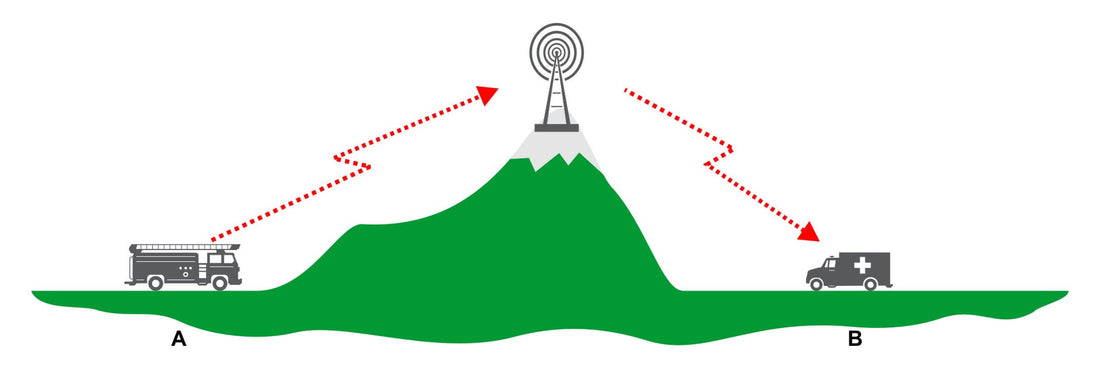
BridgeCom Systems Guide to Repeater Systems, With An Emphasis On Duplexers.
Have you ever wondered what makes a repeater system? Or interested in setting up your own system? This article will explain all the components of a repeater system. With an emphasis on duplexers and why a person would get one.
Parts of a repeater system
A repeater systems contains 5 core parts. They are the power supply, Repeater, duplexer(optional), feed line, and a antenna(s). We will breakdown all of the parts in the next few paragraphs
Power Supply.
Most electronic devices require DC(Direct current) Power. The electricity that comes out of your wall socket is in fact AC (alternating current). Your power supply is responsible for converting the AC into DC. It is also responsible for getting the correct power to the device. Your power supply will regulate the current and prevent surges from destroying your equipment. Duracomm Power supplies work fantastically for any radio application.
You can find them at the bottom of the article.

Repeater
The purpose of a repeater is to extend the range of other radios. Think of it as a signal amplifier. For example; A handheld or mobile radio in a vehicle will transmit to the the repeater. The repeater will then receive that signal and then immediately transmit it over a much larger area. Repeaters are generally mounted on high altitude locations relative to the surrounding area.

Duplexer
A duplexer is a tunable pass, pass/notch, or notch filter. It separates the transmit and receive signals. A repeater With a duplexer can transmit and receive simultaneously. Using a duplexer allows you to use only one antenna instead of two. And thus half the feed line. The advantage of using only one antenna saves money but also is quite helpful on congested tower sites. Where it may not be possible to get two antenna locations.

Feed Line
Feed line is simply a specialized wire that transmits signal from the repeater to the antenna and back.

Antenna
The antenna is where the signals go in and out. If you have a duplexer, only one antenna is required. If not, two are required. One for transmit, and one for recieve.

Why A Duplexer:
Cost Savings - Use only 1 antenna and feed line.
Using a duplexers enables the use of only one antenna and feed line. Eliminating the second antenna and feedline set. This can save hundreds if not thousands of dollars in equipment!
Convenience - Do half the work.
By only having to mount 1 antenna. You are cutting the amount of work in half. This gets the system up faster and leaves more time to talk on the system.
Now you only need one antenna location. If you have a tower you can now use the top instead of having to use the top and a lower location on the tower. Using the top enables maximum coverage.
Accessibility - Only secure one tower spot.
In a lot of areas tower space is in high demand, very limited, and expensive. It can be hard to get a spot to mount 1 antenna, let alone 2. Having a duplexer makes getting a tower slot much easier and a lot cheaper. Leasing a slot for one antenna on a commercial site could cost $5000 a month! Double that or more for 2 antenas. If that isn't enough to convince you I don’t know what will.
Good news. -BridgeCom Systems has everything you need.
BridgeCom Systems Supplies all of those components, and will help find what you need. Not only is having a duplexer convenient. Getting an all included repeater system package from BridgeCom Systems is even more convenient! Please call us at 816-532-8451, send us an email at ContactUs@BridgeComSystems.com or visit our product selection.
Our Repeaters and Duplexers have been tried and tested all over the world.
Check out our testimonials page for proof
https://www.bridgecomsystems.com/blogs/bridgecom-brag-board-testimonials
Repeaters: https://www.bridgecomsystems.com/collections/amateur-radio-repeaters
Duplexers:
VHF: https://www.bridgecomsystems.com/collections/vhf-duplexers
220: https://www.bridgecomsystems.com/collections/220-duplexers
UHF: https://www.bridgecomsystems.com/collections/uhf-duplexers
Power Supplies
Desktop: https://www.bridgecomsystems.com/collections/desktop-power-supplies
Rack Mount:https://www.bridgecomsystems.com/collections/rack-mount-power-supplies
Feed line: https://www.bridgecomsystems.com/collections/heliax
Antennas
VHF: https://www.bridgecomsystems.com/collections/vhf-antennas
220: https://www.bridgecomsystems.com/collections/220-antennas
UHF: https://www.bridgecomsystems.com/collections/uhf-antennas
If you don’t find what you looking for. Call us at 816-532-8451 or send us an email at ContactUs@BridgeComSystems.com
If you have any input on the article, please leave a coment below.







18 comments
Good quality
Our Amateur Radio Club, Iroquois County Amateur Radio Club, has a UHF and VHF Repeater (call sign AD9L) covering Iroquois County Illinois and a number of other counties in East Central IL and West Central Indiana we are looking to upgrade these sites but are not able to afford it yet.. Winning this system would help us to do that and even link with other repeaters to the north of us for SKYWARN operations. Please select us for the award.
Mike Marcier – KC9HHT
H, there is no 220 NHS. Repearter here in Vernon parish so I want so much to put up a 220 repearter but the cost is the mean thing I am only a poor amateur radio operator that wants one here for others to be able to use. De k5geb. Gary Edward brewer
We’re fortunate. We already have space available on the same tower we currently utilize. I spent 18 years installing systems overseas for VHF & UHF and taught personnel how to tune Duplexer systems should the need arise.
Got it. Bookmarked this. Thank you. 73!